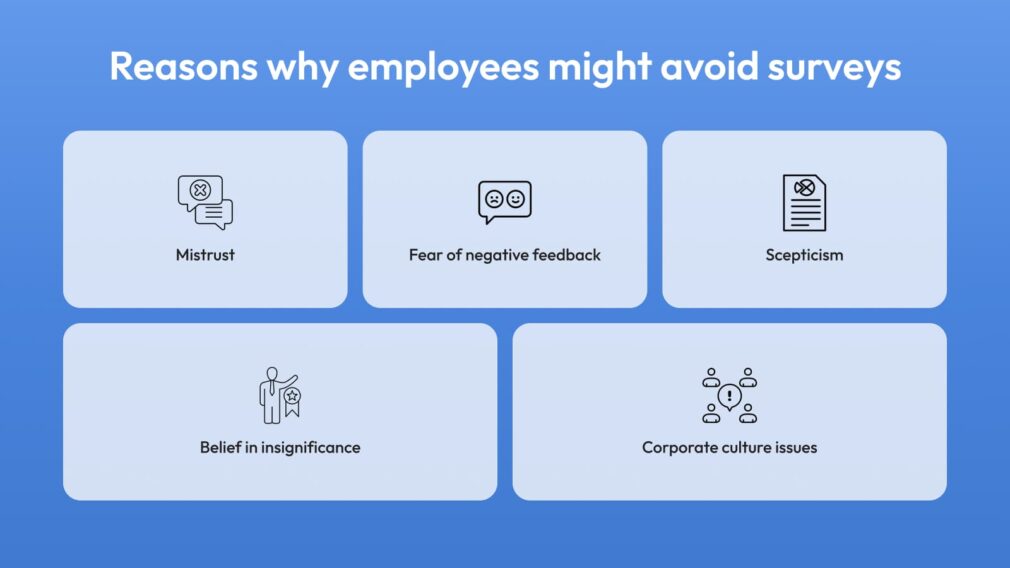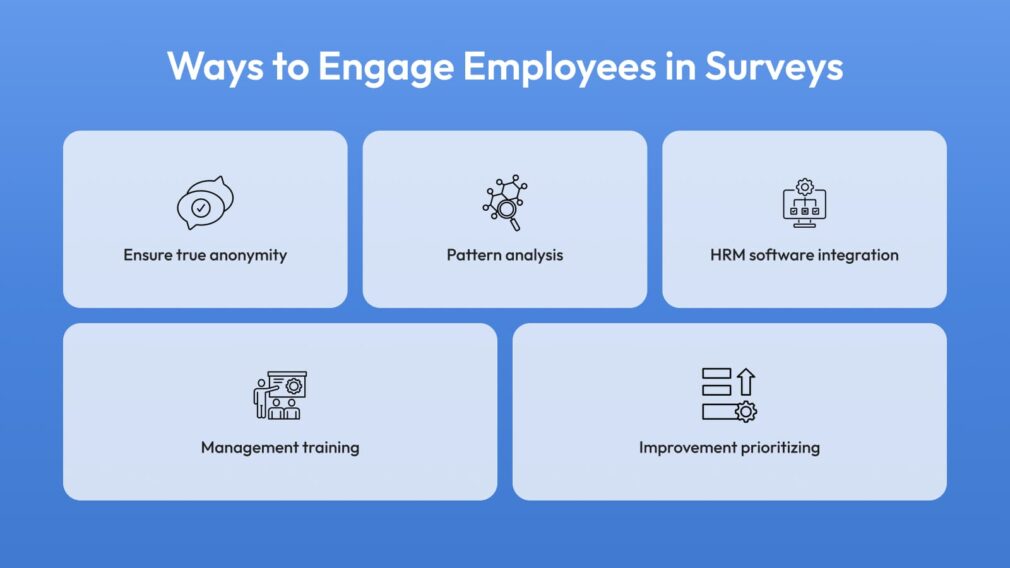For a while, companies and organizations of different scales started actively incorporating the method of incognito surveys among workers. This practice helps gather valuable insights based on feedback for improving internal organization transparency and employees’ work comfort and well-being.
Such surveys serve a positive purpose, but sometimes they appear “anonymous” instead of anonymous. Sometimes, employers use this term just nominally but, in fact, fire employees for their honest responses.
In this post, you’ll be able to overview anonymous surveys phenomenon, their impact on internal cooperative culture, and the methods to improve trust between staff members and employers in more detail.
How Anonymous Surveys Work and Why Employees Are Fired?
The primary purpose of any enterprise’s internal anonymous survey is to gather valuable insight from employees without revealing their identities. The anonymity factor always stimulates people to provide more candid feedback streamed to improve particular work aspects.
This tactic may facilitate significant improvements like well-managed and transparent communication, swifter and easier problem-solving tactics development, improved job retention and satisfaction rates, guidance of strategic decisions, etc.
Nevertheless, this method allows companies to focus on resolving a specific issue, targeting one problematic area instead of working on amorphous changes that are usually left unnoticed.
In recent years, the public became aware of incidents when workforce members (respondents) were fired for taking unnamed surveys. Such actions may harm employees and the company, bringing bitterness and toxic traits to a corporate culture and depriving valuable insights for company’s future growth.
Here are some common reasons why employers fire their staff based on their responses:
Companies’ internal culture. Sometimes, a company’s culture sadly may not be based on mutual respect, and constructive feedback and open communication may not be valued. This becomes an issue as the employer perceives any kind of critical consumption as a threat and chooses to terminate the employee.
Pseudo anonymity. Quite often, surveys that are meant to be anonymous may still reveal the identity of a respondent. An employer may take actions based on previous biases that occurred with a particular employee instead of considering the message of actual feedback.
Retaliation. The management might use such surveys as an instrument against the workers who raised concerns and criticized their practices.
Lack of understanding. The majority of firing cases show that the employers may not fully understand the primary purpose of surveying. An employer may see candid feedback as an insult rather than an opportunity for future improvement.
Budget restrictions. In situations when cutting-cost measures are needed, for some employers, firing employees is the easiest method. In that way, the survey results may be taken as an excuse for reducing the workforce.
These facts became a starting point for employees to mistrust and simply refuse to take anonymous surveys. Some people have had a dissatisfying past experience, while others have seen such a situation involving a friend or a colleague. Let’s see and analyze the most widespread reason for employees to avoid participating in anonymous surveying.
Reasons Employees May Avoid Taking Anonymous Surveys
The core reasons are mostly based on strong misunderstandings and communicational issues. As practice shows, their concerns may appear valid. Let’s dive deeper and extract the primary problematics.

Mistrust
As discussed before, employees may doubt the promise of complete anonymity. By avoiding participation, they may attempt to protect themselves from the responses being tracked back to them and the following aftermath with the management.
Fear of negative feedback
Sometimes, even if the anonymity is reassured, the worker may still have particular prejudices. This may be connected to the fear of negative feedback from colleagues or supervisors and their possible negative perception of the answers.
Particular skepticism
In addition to the previously mentioned aspects, let’s imagine an individual who already has taken such surveys. The person shared their candid feedback, then went through a hard discussion with management and still hasn’t noticed tangible changes. Sure enough, their expectations failed, and it will probably be useless for them to give it another chance as nothing changes.
The belief in insignificance
Stemming from the previous reasoning, some employees may not fully comprehend their importance. Such beliefs are usually widespread in large organizations and companies, where a particular employee’s voice may be lost in masses of other individuals.
Core internal corporate culture issues
Some enterprises might have a history of punitive actions that may significantly affect employees’ trust. Their concerns may be connected to proper anonymity safeguarding and the consequent unpredictability of the management actions.
Despite all these factors, gathering employees’ feedback anonymously may deliver significant positive outcomes to the organization’s efficiency and communicational environment. So, let’s see how it is possible to improve employees’ trust rate and obtain a mutual understanding of the survey’s purpose.
5 Ways to Engage Employees to Take Anonymous Surveys
Besides creating a welcoming work environment, you can do a couple of things to build trust and strong communication.

Ensure true anonymity
It’s crucial to deliver the message that the employees will receive complete anonymity, and their identity won’t be revealed. It’s advisable to replace the term ‘anonymity’ with ‘confidentiality’ as this will be perceived as something more secure and will encourage honest feedback.
Definition and analysis of patterns
While analyzing the responses, define the regularity of spotting particular patterns instead of focusing on individual opinions. This enables the full overview of the repeating issue and then the swifter decision-making on how to resolve it.
Implement HRM software
HRM or Human Resource Management software development and implementation may decrease misunderstandings and improve communication. This digital tool is utilized to manage HR functions and boost their completion efficiency.
HRMs help to assure true anonymity by gathering answers without linking them to a particular person, encouraging workers to be more frank in their responses. Nevertheless, such a solution helps to establish high transparency, letting employees know how and for what purposes their data will be used. Also, HRM software allows managers to define systematic issues, providing wide analysis and, in response, showing employees what actions were taken based on their input.
Management training
Guiding management in perceiving and analyzing feedback constructively is necessary without exaggeration. The obtained skills will help them to focus on professional interaction, minimizing the possibility of taking things personally and softening their reaction to negative responses.
Improvement prioritizing
The main goal of any anonymous surveying is to gather internal insight to increase the company’s functioning quality and efficiency. Also, the organization’s internal culture’s main priority has to be a high value of employees’ opinions.
Surveying is all about identifying the issue and working on it for a positive change. Such perception allows separate personal relationships and professional communication, helping enterprises extract the use out of candid employees’ responses.
Summing Up
Anonymous surveys, while intended to gather candid feedback for organizational improvement, can sometimes lead to employee terminations due to pseudo-anonymity, retaliation, and misunderstandings. These practices foster mistrust and reluctance among workers to participate, harming both employee morale and company culture. By ensuring true anonymity, implementing HRM software, and training management, companies can rebuild trust and effectively utilize employee feedback for positive change.